Bite-sized vaccines and familiar faces
In the news this week: the medical breakthrough of a potential malaria vaccine; we find out how sewage is polluting our beaches but may also help us cope with a sulphur shortage; and a way to immunise the brain against misinformation…
In this episode
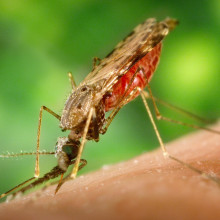
00:58 - A potential breakthrough in malaria vaccines
A potential breakthrough in malaria vaccines
Mary Hamel, World Health Organisation
Malaria affects millions of people every year in the tropics, and the majority of the deaths from the disease are in young children. It's one of those diseases that's been crying out for a vaccine for decades, but it's proved a difficult nut to crack. The malaria parasite has a complex life cycle and thousands of genes making it hard to disentangle how it works and best to target it. But, this month, UNICEF have awarded a contract worth nearly 200 million Dollars to drug giants GSK to make millions of doses of a promising new vaccine candidate called RTS, which will be supplied for children at risk in the key malaria hotspots. Mary Hamel leads the Malaria Vaccine Team at the World Health Organisation…
Mary - This vaccine is made up of a protein and what's called an adjuvant, something that stimulates the immune system to work a little better. The vaccine targets the very first stage of the malaria parasite. When the female mosquito injects the parasite into the human host, the vaccine stimulates the immune system to make antibodies against the parasite so that the disease does not progress.
Chris - And how effective is it?
Mary - The phase three trials showed that the vaccine could reduce malaria in young children by over half and severe malaria by about the same. Now we're used to hearing about vaccines that are 90% efficacious, but when you have a disease like malaria, where children can have malaria infections 6, 7, 8 times per year, until they build up their acquired immunity, they're at risk of progressing to severe malaria and death. Reducing those cases by 50% can really be substantial.
Chris - Yeah. I was going to say with a disease that's killing up to a million people a year. 50% of that is still a massive saving of lives, isn't it?
Mary - That's exactly right. And we've seen just this in the pilot implementations
Chris - And this present announcement is an award of a large tranche of funding to get those vaccines manufactured and then out there into the field.
Mary - That's right. This is really a major milestone. Right now over a million children have benefited from the vaccine in the pilot programs in Malawi, Kenya, and Ghana. This award, and this contract between UNICEF and the manufacturer, means that millions more children will benefit in other countries. There can be expansion, but there is a challenge here. And that is that the demand for this vaccine is very high. There are more than 25 million children who live in these areas of high risk for malaria and severe malaria. And that means that at a steady state, it's estimated that over 80 million doses of vaccine will be needed each year. So this is a challenge that WHO, GAVI, and other partners are working on now as a priority. There's what's called a market shaping team that's working specifically to find ways to increase supply and decrease cost so that this vaccine can reach all these children who are living at risk.
Chris - So where do you see the numbers going once this money starts to flow? Once these vaccines start to make their way into the field, if we have this conversation in five years time, and you're looking back, what will you say happened since?
Mary - I think what we will be seeing five years from now is that there's more than one vaccine available, that prices come down substantially, that the global health architecture that was put in place to support vaccines reaching these children who are living in these areas of high need, that it has been successful, and that continues with a major impact in child deaths.
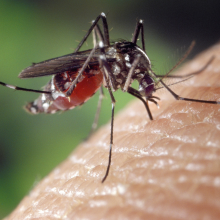
05:06 - Malaria vaccine delivered by mosquito's bite
Malaria vaccine delivered by mosquito's bite
Sean Murphy, University of Washington
This week researchers at the University of Washington have published some encouraging data from a clinical trial they’ve been running using a live malaria vaccine that they’ve developed. Long term, they’ll make the vaccine in a test tube, but for now, while they work out its feasibility and effectiveness, they’re testing it by using mosquitoes themselves to vaccinate people! Sean Murphy…
Sean - The world needs a very highly effective malaria vaccine and, while a new vaccine was approved late last year, the efficacy of that vaccine is not as high as we would like. So one of the most successful ways to make vaccines is to take the organism that causes the disease and to weaken it and turn it into a vaccine. People have been trying to do that for malaria for actually decades and this study showed that this could be a very effective approach.
Chris - So how have you weakened it?
Sean - Well, the DNA of the malaria parasite has more than 5,000 genes. And, leading up to this study, some of the researchers involved figured out some genes that were really important for the parasite to survive in your liver. And if they made changes to the DNA, so that those genes no longer worked, they found that now the parasite couldn't make it through the liver stage. And therefore couldn't go on to cause like disease that we would see with a normal parasite.
Chris - How did you test this then? Because, obviously malaria is transmitted by mosquitoes normally, so how would you vaccinate a person?
Sean - So in this study, we actually use the mosquitoes as tiny little flying syringes because the form of the parasite that serves as the vaccine, we can only right now make it in mosquitoes. And what we know is that if people get about a thousand mosquito bites with these weakened parasites, they can end up being protected against the later 'challenge' with mosquitoes that carry the regular old malaria parasite.
Chris - How on earth do you persuade people to get a thousand mosquito bites?
Sean - Yeah. Well, first of all, it's not a thousand in one sitting, let me be clear about that. The bites were administered about 200 bites per sitting, and some people had some pretty intensely itchy arms after that. And so we pay a lot of attention to how to limit that. But, within a matter of a few days, usually that went away. But that was our strategy for vaccinating and the volunteers were really wonderful and generous of their time.
Chris - And what happened when these people got these hundreds of mosquito bites, did they mount a malaria response?
Sean - It's very clear that the people definitely mounted an immune response. We can see that people are making antibody responses against the parasite, but we also know that there are probably immune responses that we cannot measure when we just take blood from a vein. And that's why the challenge model is so important for us to actually be able to measure whether we succeeded or didn't with the vaccine.
Chris - And when you say challenge model, this is you coming along later and physically trying to infect people with malaria for real, to see if they're protected by the prior exposure to the weakened vaccine strain.
Sean - Yeah, that's correct. And we challenge them with usually five mosquito bites. We follow them for the emergence of the parasites in their blood, which would indicate that whatever we were trying to protect against in the liver did or did not work. So someone who had a good vaccine response wouldn't have the parasites emerging in their blood ever because they would be completely protected and we can follow that really closely.
Chris - And is that what you saw?
Sean - So what we saw in this study was that half of the vaccinated people were completely protected against infection. It's a very high bar to achieve complete protection against because even just one of the parasites that comes from the mosquito can go on to ignite the blood stage infection later on. So 99% reduction is not enough. You really have to achieve a hundred percent eradication of the parasite in your liver. What this study tells us is that this genetically attenuated parasite approach is actually quite promising. And the reason that we're not disappointed that we didn't get a hundred percent protection, is that we know that if we put the vaccine in by needle and syringe, it's likely to have a higher rate of protection. And that's because every time we give mosquito bites, the vaccine is to some extent stopped in its tracks right there in the skin. But if we give it by needle and syringe, it's likely that more of the vaccine will get to the liver. And if it gets to the liver, we think more of it will be able to do its purposeful role as a vaccine.
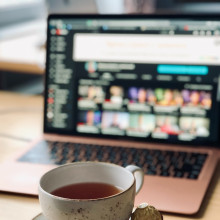
11:33 - Videos immunise viewers against fake news
Videos immunise viewers against fake news
Jon Roozenbeek, University of Cambridge
In the digital age, misinformation and fake news have become major obstacles. Dodgy stories can spread like wildfire: drugs for treating Covid, 5G and vaccines have all been recent victims of misinformation campaigns propagated online. So how can we counter the threat? According to Cambridge University’s Jon Roozenbeek, who’s just published a study on this, the answer is to show people how to recognise the tell-tale signs of a social media porky, as he told Julia Ravey...
Jon - The way we've gone about doing that is basically by creating a couple of very short videos of about minute and a half long, and each of these videos shows you a way in which people might be manipulated online. For example, by playing into your emotions, right? Like if you write a headline that is intensely emotional, seeks to evoke fear, anger, outrage, and so on, it diverts your attention away from the accuracy of that headline in some way. But if you can point that out, for example, in a video, people actually become less susceptible to that kind of manipulation.
Julia - And with these videos, where did you play them?
Jon - So we did a bunch of lab studies first to see if there was a proof of concept here. Because if you don't do lab studies first, then you can't really do anything else. That turned out to work really well and then after that, we went to YouTube. So we ran these videos as YouTube ads - about 5 million people could have seen this video or one of these videos as a YouTube ad. And then after that, we asked these people a single question. We gave them a headline and asked "Do you think any kind of manipulation is being used in this headline? If so, please identify it." And they got a number of response options, a couple of options to choose from and they could be wrong or correct. We had a control group as well, which didn't see any of the videos, but they did get the survey question. And what we wanted to see was are the people who watched the video better at this than the control group? And they were.
Julia - With the videos being on YouTube. I know YouTube ads, a lot of people skip YouTube ads. Is there a way that if you roll these out to protect people against misinformation online, that we could definitely make sure people are watching these ads, taking them in and not just skipping over them?
Jon - The response rate was about 19% approximately, meaning of all of the people who were shown the ad about 19% actually watched them for a meaningful period of time. That was quite nice. And the way that we've tried to do that was by making the videos a bit more fun than usual, I suppose, like trying not to be boring, which scientists have a habit of doing. For example, in every video, we used an example from pop culture; Star Wars, Family Guy, South Park, and so on, to explain how these manipulation techniques might be used. For instance, there's a scene in Star Wars - Episode III, I believe, where Anakin Skywalker, who's just about to the bad side, tells Obi Wan Kenobi, "If you're not with me, then you're my enemy, right?" Which is a telltale example of a false dichotomy, which is one of the techniques that we wanted to train people to recognize, which is when you're presented with two options when in reality there's actually more. You can be critical of Ankin, but also not be his enemy. There's a third way there that's also a possibility.
Julia - That's so interesting. So what were the other things you were trying to teach people with these videos? So we have false dichotomy. What were a few of the other things that you were trying to point out?
Jon - An other one was emotional manipulation, the one I just explained. Then there was incoherence, which is mutually exclusive arguments. So for example, in climate change, you get people saying it's not global warming, it's global cooling that's happening. And at the same time, they'll say climate models are bad. We can't predict what will happen to the climate. Like these two arguments rule each other out, you can't use them at the same time. The fourth one was Ad hominem attacks; attacking the person, not the argument, which sometimes makes sense. For example, if a tobacco company says "vaping is safe", you're like, well, considering your track record, I'm a bit skeptical. But nonetheless, in other cases, this actually is very manipulative and it isn't something that you would expect a reasonable debater to do. And then the fifth one was scapegoating. So that happens quite often with groups of people who are being held responsible for a very complex problem that has multiple causes, but singling out one group or one person is a very commonly used manipulation tactic in hate speech.
Julia - And from the results of your study, how effective do you think this technique could be if it was rolled out more widely to immunise people against misinformation online?
Jon - The study was unique in the sense that it demonstrated the actual scalability of this approach on social media. We ran an anti misinformation campaign on YouTube, as you actually would, there was no little to no daylight between what we did and what someone who would actually run an anti misinformation campaign on YouTube would do. It's pretty much the same thing. So that demonstrates the scalability, which is great. At the same time, that doesn't mean that we solved the problem. For example, we weren't able to look at what happens with how people behave online. So we don't know if, for instance, if they watch the video about emotional manipulation, if they then also start sharing less negative emotional content with each other. So that's a subject for future research.
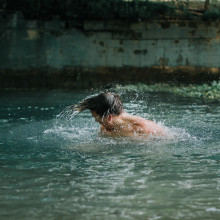
17:16 - Faulty sewage sensors cause a stink
Faulty sewage sensors cause a stink
Hugo Tagholm, Surfers Against Sewage
There has been a big stink in the media over the amount of untreated sewage being released along the UK coastlines, sometimes without anyone realising. Indeed, one report claims devices installed by water companies to monitor water quality failed to pick up a quarter of sewage dumps last year; in some cases, the equipment failed 90% of the time.
Perhaps as a result, following a bout of heavy rain, a pollution warning has gone out across 40 public beaches and swimming spots recently, and lead to renewed calls for action. Will Tingle spoke with Hugo Tagholm, Chief Executive and Co-founder of Surfers Against Sewage, about the potential implications these sewage dumps could have on public health…
Hugo - We're tracking thousands of sewage pollution events every year at beaches and at rivers. We know that last year alone water companies in England discharged over 2.6 million hours of sewage pollution, 370,000 separate events, at some of our best beaches and bathing waters. We tracked almost three and a half thousand sewage events and that's sort of between the red and yellow flags where people like to swim and expect never to come into contact with industrial pollution. So if we are now hearing that there aren't enough sensors and some of the sensors maybe faulty or broken, then perhaps what we are dealing with is just the tip of the iceberg for the problem for our beaches and for our coastline and maybe on a bigger scale for our rivers too. So we are really concerned. The water industry is presiding over a tidal wave of sewage, and it's simply not good enough.
Will - And is the reason behind the lack of this monitoring equipment simply because they aren't there or just that they're faulty?
Hugo - The industry now has an obligation to monitor and report on sewage discharges. Clearly, there's a process of installing and managing these sensors. It's these types of sensors that give us the data for the safer season river service, the real time data that we can give to the public to keep them safe and make sure they have the cleanest swimming experience at the beach. But the reasons behind the water industry not yet being fully up to speed with this are probably numerous. This is about the time it potentially takes to install them and manage them. And the investment it takes, but they have the money, they have the engineers and they have the resources. So we need to see them moving faster because that information is key to making the investments in the right places to end sewage pollution and protect our rivers and protect our coastline.
Will - We don't want any sort of water contamination, particularly in areas that we swim. So what kind of health problems could people be looking at if people are to swim in these waters?
Hugo - People shouldn't ever be exposed to sewage pollution. It could carry all sorts of pathogens that can make people ill, stomach infections, ear, eye, nose, throat infections. And it carries emerging threats like antibiotic resistant bacteria, which we've done studies on with the European Centre for the Environment and Human Health, which show that regular swimmers have three times the level of antibiotic resistant bacteria in their guts than the background population, even if it's diluted it still poses a big threat to human health. Dilution is not a solution. We really need to see the right solutions in place to protect both people and the environment from sewage pollution. Just 14% of our rivers meet good ecological status, our bathing water, sadly, languishes at the bottom of the European bathing water tables. We should be doing much better in aiming to have the best rivers in the world and also the best water quality in the world.
Will - And aside from holding our water and sewage companies accountable, is there anything else that we could be doing to improve the water quality of our UK coastlines and rivers?
Hugo - This is tightly linked to both the climate issue and the rewilding or the restoration of nature issue. We should be restoring nature, and there's a big movement to restore both terrestrial and marine ecosystems. There's CCGrass and oyster beds and kelp forests, on land forests, our rivers and natural habitats. And those land based ecosystems can take the pressure off water systems. They can slow down water, absorb the water in a more natural way and relieve that pressure on the sewer systems. Personally, people can also make sure they behave responsibly with water, you know, not wasting water, not flushing the wrong things down the loo, but this isn't an individual responsibility sort of issue. This is about an industry that is very profitable, can afford to build the infrastructure and invest in nature based solutions and make sure they're creating a system that's fit for the future, fit to face climate change, and fit both to supply water and protect nature at the same time.
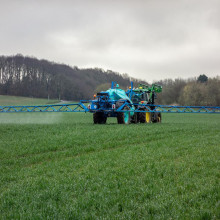
22:26 - Sulphur supply on the decline
Sulphur supply on the decline
Simon Day, UCL
While sewage is something we aim to avoid, our re-use of waste water may soon be an important way of combating another oncoming crisis: a lack of phosphorus for fertiliser. Because as fossil fuel use declines in line with emissions targets, the supplies of sulphur this industry produces as a by-product will also dry up. That means we’ll be short of sulphuric acid, which we currently use to make fertiliser from phosphate-rich rocks, as UCLs’ Simon Day explains…
Simon - Sulphur is critical to the production of phosphate fertilisers. Phosphate rock, which is the obvious raw material, is inert and can't be used by plants to any great extent. But if that phosphate rock is treated with sulphuric acid to produce things like phosphoric acid, hydrogen phosphate, phosphate salts like ammonium, so on, those are the usable fertilisers. So sulphur in the form of sulphuric acid is absolutely critical to the production of those fertilisers. And because sulphuric acid is essentially a waste product of the fossil fuel industries, which those industries are essentially giving away, that makes phosphate fertilisers very cheap compared to what its price was say 40 or 50 years ago. And consequently, there's a tendency to overuse it and we see the environmental damage as a result.
Will - So we're moving away from our use of fossil fuels?
Simon - So we are anticipating over the next few decades, if we're going to get net zero by 2050, a very great reduction of extraction of fossil fuels from the ground. Therefore the processing of those fossil fuels, which begins with the separation of the sulphur component of the fuels, means that over the next 30 years, we can anticipate a dramatic collapse to maybe a fifth, maybe a tenth, of the current supply of sulphur. And at the same time, because populations are increasing, we're looking at an increase in the demand for phosphate fertilisers, and therefore an increase in demand for sulphur to produce those phosphate fertilisers. And also many of the metals that we're going to rely on to enable the transition away from fossil fuels like metals for batteries, metals for electric motors, which also require large amounts of sulphuric acid for their extraction. We need to look at recycling phosphate that we've taken out of the fields in the food that we eat and get that phosphate back to the fields.
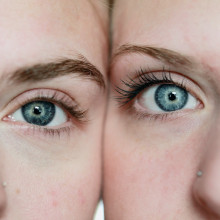
25:32 - People who look alike share similar DNA
People who look alike share similar DNA
Manel Esteller, Josep Carreras Leukaemia Research Institute
Scientists estimate that about 80% of the genes we carry are involved in building the structure of our faces and hence the way we look. And so we’ve always suspected that, potentially, if you find someone who looks very like you, chances are you have a lot of the same genes in common. Now scientists have confirmed that’s the case, and it unlocks the possibility of predicting what someone might look like, based just on their genetic code. Julia Ravey spoke to Manel Esteller, from Josep Carreras Leukaemia Research Institute (IJC) in Barcelona, who’s been comparing people who aren’t related but nevertheless look very much alike…
Manel - We started with different levels of complexity in cells to know what is the main contributor to having similar faces; genetics, epigenetics - that is the regulation of DNA - and the microbiome - how many bacteria? What type of bacteria? It's difficult to give a number, but you can imagine that around 1000 to 2000 genes are relevant for the shape of our face.
Julia - And there are people out there who aren't twins. They're not even related as far as they know, but they look really, really similar. So why is this?
Manel - This is our study. Our study looked at these people that look very similar, but they're not related because we have gone back hundreds years, we have seen that these people that share very similar faces are not in any way related by family. And in this case, they share these genetic variants that relate to the shape and volume of our mouth nose, eyes, cheeks, but also to our height and weight.
Julia - Why do you think that there are these commonalities between people that aren't even related?
Manel - It's difficult to know why, but the most logical explanation for us is that this is happening by random chance. So there are now so many people in the world that they share these particular genetic sequences that relates to the shape of our face. Now we have more ways to find these people because internet and all the apps, the young generations and teens are now able to catch another person that looks like them.
Julia - Beyond the face, were there any other characteristics that these individuals had in common in terms of their genes?
Manel - There were other parts of the body that were related in this case. And also some other traits, like for example, the use of tobacco, the smoking, and to be right or left handed, they were shared. So this probably goes a little bit beyond the face.
Julia - And you sometimes see people in couples actually look very similar. Sometimes we're attracted to people who look like us. So is there any need to be worried if you're in a relationship with someone who looks a bit like you in terms of potentially having some recessive traits that might come together in offspring to produce something which isn't overly great?
Manel - In theory, from a genetic point of view, it's better that you mix up with somebody that is different. In fact, some people that live together, they start looking similar and because they live in the same environment, you know, the same contamination or the same job, they eat the same things. So it's possible that recent conversions later in humans, these things are not inherited, they are acquired. They relate a lot of them to epigenetic changes, the content of the microbiome, and these are things that relates to our lifestyle.
Julia - So if I find someone who looks like me say on the other side of the world, I shouldn't be worried that I've got a long lost twin?
Manel - If it's perfectly identical, you can worry, but being perfectly identical, it's very difficult. So they look alike, but they're not, of course, perfectly identical. You can only be a copycat if you share 100% of your genome.
Julia - What are the consequences of this work?
Manel - Maybe now from DNA, we can think of constructing a face and this can be important in forensic medicine, for example, to find somebody responsible of a crime, just from the DNA, to be able to draw a face. So maybe now there are some data you can start doing that.

30:05 - How can medication impact salt absorption?
How can medication impact salt absorption?
Otis Kingsman spoke to Georgetown University's professor of medicine, Joseph G Verbalis to find the answer...
Joe - Now hyponatraemia refers not to low sodium in the body. It refers to low sodium concentration in the blood, and that can be caused by two different mechanisms. The first is in fact a excess loss of body sodium, but the more common ideology is an excess of body water due to the inability of the kidney to maximally excrete all the water consumed
Otis - Hyponatraemia is generally caused by a low salt diet, rather than medication. On the off chance, however, it's due for drugs causing the kidneys to not dilute for urine, leaving the concentration of salt in the blood to be much higher.
Joe - If you drink a lot of fluid, I don't care what kind of fluid it is, your body reacts by suppressing the secretion of the hormone from the pituitary called arginine vasopressin (AVP), that controls kidney water excretion. When you suppress the level of AVP, the kidney can excrete up to 20 litres a day, which protects us against becoming hyponatraemic
Otis - Excess water that would dilute for salt in our blood too much is put into urine to be excreted through the kidneys.
Joe - But many drugs cause an inability of the pituitary to completely suppress antidiuretic hormone (AVP). And in that case, the kidney cannot maximally excrete the free water. And if that occurs, then if more water than that is consumed, then that will accumulate in the body. That will then dilute the sodium concentration down to a lower level, which we call hyponatraemia.
Otis - Most medication doesn't affect our ability to absorb salt. It affects our inability to excrete the maximum amount of water from the body.
Joe - So, Kandi, most medications do not cause the body to fail to absorb or use sodium. They caused the body to retain excess water. And the treatment for that is not to take more sodium in, it is to limit the amount of water that is ingested. Again, not necessarily only water, but any fluids that are ingested, because most fluids are largely water.
Otis - Thank you to professor Joe Verbalis for helping us find the answer. Next week, we'll be splashing about in this science question from listener Ed:
Ed - Is it recommended to drink Cola after swimming in a river, and does it really reduce the risk of getting an upset stomach?
Related Content
- Previous Apollo Remastered
- Next Spacewalk: the Scale of our Solar System










Comments
Add a comment